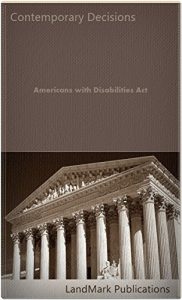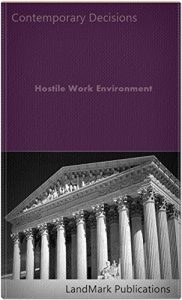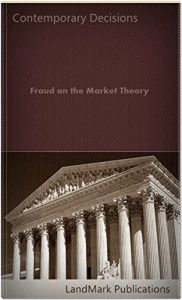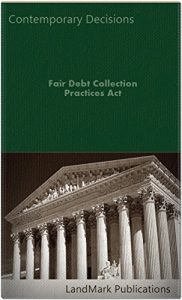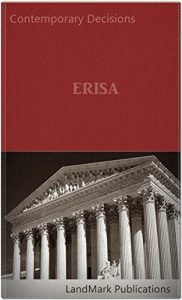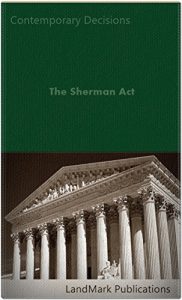THIS CASEBOOK contains a selection of 248 U. S. Court of Appeals decisions that analyze, interpret and apply provisions of the Americans with Disabilities Act. The selection of decisions spans from 2005 to the date of publication.
The ADA and Section 504 [of the Rehabilitation Act of 1973] make it unlawful to discriminate against a "qualified individual with a disability" because of the disability. Bahl, 695 F.3d at 783. [Footnote omitted.] In order to establish disability discrimination under the ADA, [a plaintiff] must first show that she "(1) is disabled within the meaning of the ADA, (2) is a qualified individual under the ADA, and (3) suffered an adverse employment action because of her disability." Walz v. Ameriprise Fin., Inc., 779 F.3d 842, 845 (8th Cir. 2015). To be considered a qualified individual under the ADA, an employee must "(1) possess the requisite skill, education, experience, and training for [her] position, and (2) be able to perform the essential job functions, with or without reasonable accommodation." Hill v. Walker, 737 F.3d 1209, 1216 (8th Cir. 2013) (quoting Fenney v. Dakota, Minn. & E. R.R. Co., 327 F.3d 707, 712 (8th Cir. 2003) (alteration in original)). "Discrimination includes 'not making reasonable accommodations to the known physical or mental limitations of an otherwise qualified individual with a disability . . . unless [the employer] can demonstrate that the accommodation would impose an undue hardship on the operation of the business of [the employer].'" Dropinski v. Douglas Cty., Neb., 298 F.3d 704, 707 (8th Cir. 2002) (quoting Heaser v. The Toro Co., 247 F.3d 826, 830 (8th Cir. 2001)) (alterations in original). Scruggs v. Pulaski County, (8th Cir. 2016).
Modeled on Title VII of the Civil Rights Act of 1964, the ADA incorporates that statute's enforcement provisions, including [ ] the requirement that a plaintiff exhaust her administrative remedies before seeking judicial redress. See, e.g., Bonilla v. Muebles J.J. Alvarez, Inc., 194 F.3d 275, 277-78 (1st Cir.1999). More specifically (and simplifying slightly, without affecting the analysis), one part of the statutory schematic creates federal jurisdiction over all "actions brought under" the statute, see 42 U.S.C. § 2000e-5(f)(3); and another sets out conditions precedent to bringing suit, among which are filing a timely charge with the EEOC, see id. § 2000e-5(e)(1), and receiving an EEOC right-to-sue letter before suing in federal court, see id. § 2000e-5(f)(1). Martinez-Rivera v. Commonwealth of Puerto Rico, 812 F. 3d 69 (1st Cir. 2016).
The ADA and Section 504 [of the Rehabilitation Act of 1973] make it unlawful to discriminate against a "qualified individual with a disability" because of the disability. Bahl, 695 F.3d at 783. [Footnote omitted.] In order to establish disability discrimination under the ADA, [a plaintiff] must first show that she "(1) is disabled within the meaning of the ADA, (2) is a qualified individual under the ADA, and (3) suffered an adverse employment action because of her disability." Walz v. Ameriprise Fin., Inc., 779 F.3d 842, 845 (8th Cir. 2015). To be considered a qualified individual under the ADA, an employee must "(1) possess the requisite skill, education, experience, and training for [her] position, and (2) be able to perform the essential job functions, with or without reasonable accommodation." Hill v. Walker, 737 F.3d 1209, 1216 (8th Cir. 2013) (quoting Fenney v. Dakota, Minn. & E. R.R. Co., 327 F.3d 707, 712 (8th Cir. 2003) (alteration in original)). "Discrimination includes 'not making reasonable accommodations to the known physical or mental limitations of an otherwise qualified individual with a disability . . . unless [the employer] can demonstrate that the accommodation would impose an undue hardship on the operation of the business of [the employer].'" Dropinski v. Douglas Cty., Neb., 298 F.3d 704, 707 (8th Cir. 2002) (quoting Heaser v. The Toro Co., 247 F.3d 826, 830 (8th Cir. 2001)) (alterations in original). Scruggs v. Pulaski County, (8th Cir. 2016).
Modeled on Title VII of the Civil Rights Act of 1964, the ADA incorporates that statute's enforcement provisions, including [ ] the requirement that a plaintiff exhaust her administrative remedies before seeking judicial redress. See, e.g., Bonilla v. Muebles J.J. Alvarez, Inc., 194 F.3d 275, 277-78 (1st Cir.1999). More specifically (and simplifying slightly, without affecting the analysis), one part of the statutory schematic creates federal jurisdiction over all "actions brought under" the statute, see 42 U.S.C. § 2000e-5(f)(3); and another sets out conditions precedent to bringing suit, among which are filing a timely charge with the EEOC, see id. § 2000e-5(e)(1), and receiving an EEOC right-to-sue letter before suing in federal court, see id. § 2000e-5(f)(1). Martinez-Rivera v. Commonwealth of Puerto Rico, 812 F. 3d 69 (1st Cir. 2016).
